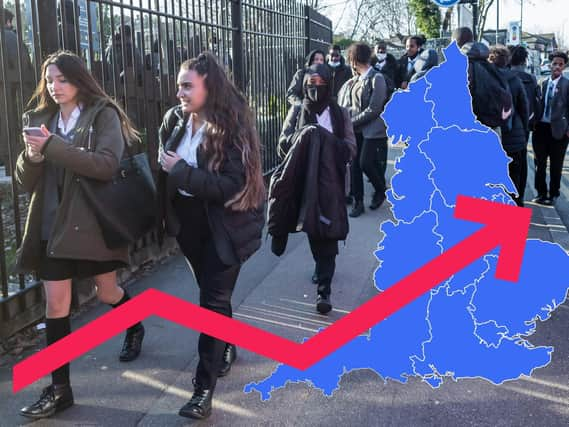Covid In Schools: Interactive map shows rise in Covid infection rates across Scarborough borough as pupils went back to school


Covid infection rates have surged across England since children returned to the classroom.
Official figures from the UK Government show infection rates increased by 13 per cent between August 31 and September 7, with positive infection rates per 100,000 people starting at 304.1 and then rising to 342.7.
Advertisement
Hide AdAdvertisement
Hide AdYou can explore the current rate of infection in your neighbourhood using the chart, or click here to see a larger version.
What are infection rates like in your local area?
In Scarborough borough the biggest jump was in Burniston, Sleights, and Flyingdales where infection rates jumped 240 per cent, with the rate climbing from 180.8 to 614.6.
• Whitby West saw a rise of 75 per cent from 287.6 to 503.2
• Falsgrave saw a rise of 73 per cent from 239.4 to 413.5
• Filey and Hummanby saw a rise of 64 per cent from 241.4 to 396.6
• Whitby South and East saw a rise of 47 per cent from 242.4 to 355.5
Advertisement
Hide AdAdvertisement
Hide Ad• Eastfield, Crossgates, and Seamer saw a rise of 10 per cent from 407.4 to 446.8
• Scarborough central saw no rise or drop, and remained at 288.8
• Wheatcroft and Cayton saw a three per cent drop from 392 to 378.5
• Ramshill and South Cliff saw a six per cent drop from 222.7 to 210.4
Advertisement
Hide AdAdvertisement
Hide Ad• Newby and Scalby also saw a six per cent drop from 348.1 to 326.3
• Esk Valley and Runswick Coast saw a 32 per cent drop from 577.1 to 394.8
• Scarborough Town and North Bay also saw a 32 per cent drop from 398.5 to 269.9
• Barrowcliff and Northstead saw a 34 per cent drop from 524.6 to 343.7
Advertisement
Hide AdAdvertisement
Hide Ad• Ayton and Snainton saw the largest fall of 37 per cent from 548.1 to 344.5
When will children be vaccinated?
While Covid symptoms in children are largely asymptomatic or mild, vaccination opened for those aged 16 and 17 in August.
The country’s vaccine advisory body, the Joint Committee on Vaccination and Immunisation (JCVI), recently said that it would not support healthy children aged 12-15 being vaccinated due to their low risk of falling ill from the virus.
However, the UK’s four chief medical officers announced on Monday that children aged 12 to 15 should be offered one dose of the Pfizer vaccine.
Advertisement
Hide AdAdvertisement
Hide AdVaccinations have so far only been offered to children aged 12 to 15 who are at higher risk from coronavirus or who live with someone who has a suppressed immune system.
Across England, nearly 800,000 under-18s have now received their first vaccine and around 158,000 have received a second dose, as of September 5.
To see the national picture of Covid infection rate data, click here.